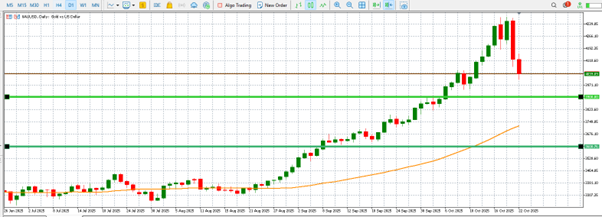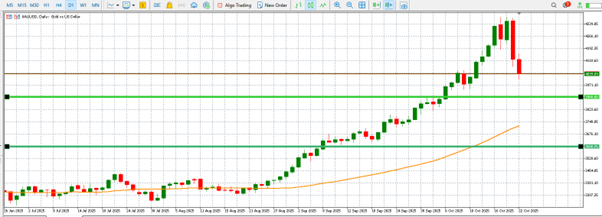Gold prices continued their historic downhill journey on Tuesday, after Monday's record intra-day fall saw the metal fall by just over 6%—its steepest fall in the last six plus years. The correction has now removed just shy of $300 off recent peaks, and spot gold trades just shy of $4,050 an ounce, having peaked just days ago at $4,380. The action represents an intense unwind of speculative positioning accumulated throughout the recent rally, as well as changing macro dynamics that have boosted the dollar and reduced safety sentiment.
Technical Exhaustion Hits Reality Check Squarely
The selloff was a reversal of the uninterrupted advances of the past few months, which pushed the price of gold to 48 record highs this year. Technical gauges, most prominently the Relative Strength Index of 80 or more last week, signified extreme overbought situations. Traders were fast to take profits once the trend was reversed, embarking on wave selling through stop-loss orders and program sales on principal exchanges.
This technical pressure comes alongside a wider risk sentiment recalibration. After weeks of fiscal and geopolitical tension, markets are now factoring in a milder tone to inter-global tensions. President Trump's statement implying his new 100% tariffs on Chinese imports would "likely be much lower" catalyzed the rally in risk assets and the US dollar rebound. Since gold is valued in dollars, the strength of the currency has therefore directly contributed to bullion's loss of value, bringing the latter back towards the near-term technical support levels of $4,000.
Macro Wind Shifts Against Gold
Apart from the technicals, various key factors are fuelling the pullback. The current United States government shutdown, now entering the fourth week, has failed to evoke the sort of panic usually assailing safe-haven assets. Instead, investors are wagering that the impasse might come to an end by the time of the Federal Reserve's October 29-30 meeting, stripping off the foremost uncertainty premium that pushed the price of gold higher this month.
At the same time, bets on this week's U.S. Consumer Price Index (CPI) release have become increasingly dovish, and the market expects cooler inflation readings. A mild CPI would make the case for a 25-basis-point rate cut stronger, but, ironically, it's also causing risk-on action in bonds and equities—and siphoning off flows from gold. The risk asset rotation is due to the view the Fed's upcoming move won't be an emergency measure, but policy recalibration.
The dollar index (DXY) holding above 103 exacerbates the pressure, typically putting the brakes on gold surges below the $4,000-$4,100 area. The metal remains acutely responsive to currency shifts: every percentage-point gain for the dollar tends to result in the 1.5-2% drop of gold prices where speculative leverage, as presently, occurs.
ETF Flows and Demand by the Central Banks: The Contradictory Signal
Though selling exists, core investment demand has not gone away. Physical ETFs for gold are still recording net inflows, holdings of close to 3,900 metric tonnes, the highest since 2020. This discrepancy between physical build-up and speculative selling highlights the market's dichotomisation—short-termers selling and long-termers holding firm. Central banks, also, have proved resilient. Annual buying is estimated at 550–600 tonnes, by far driven by emerging-market centers seeking to diversify reserves off the dollar. Steady institutional buying so far means there is a soft floor to the current correction, and the risk of structural break-down much deeper would be contained unless real yields surge higher.
Where the Correction Might Fall
Technically, gold is presently heading towards an important inflection area of $3,800-$4,000, which coincides with its 50-day moving average. An open break lower could spotlight the $3,650-$3,700 area, which would be a complete retracement of the September rally. However, failure to stabilise above $4,000 would be an indication the market is digesting its grip on the trend and not reversing.

Gold chart by XTB
Historically, bull market corrections have been fleeting. In earlier cycles, the 5-10% of all-time declines of gold have lasted between one and three weeks, then gone on to higher records. For the long-term investor, this time frame often means strategic re-entry, not exit.
Outlook: Opportunity of the Panic
Gold’s steep fall is dramatic but not unprecedented. In many ways, it’s a rational reset after a parabolic move that left valuations overstretched. Inflation remains sticky near 2.5%, central banks are still net buyers, and political risk—from tariff negotiations to fiscal brinkmanship—hasn’t disappeared. The current dip, while painful for late entrants, offers disciplined investors a more attractive entry point in a secular uptrend. If the Fed produces a dovish cut next week and the dollar declines off current peaks, gold should rapidly make back lost territory. For the time being, though, the word is this: the market had to catch its breath, and it just did. Several sessions forthcoming shall decide the question of the correction—or the start of a longer consolidation off of gold's record year.
